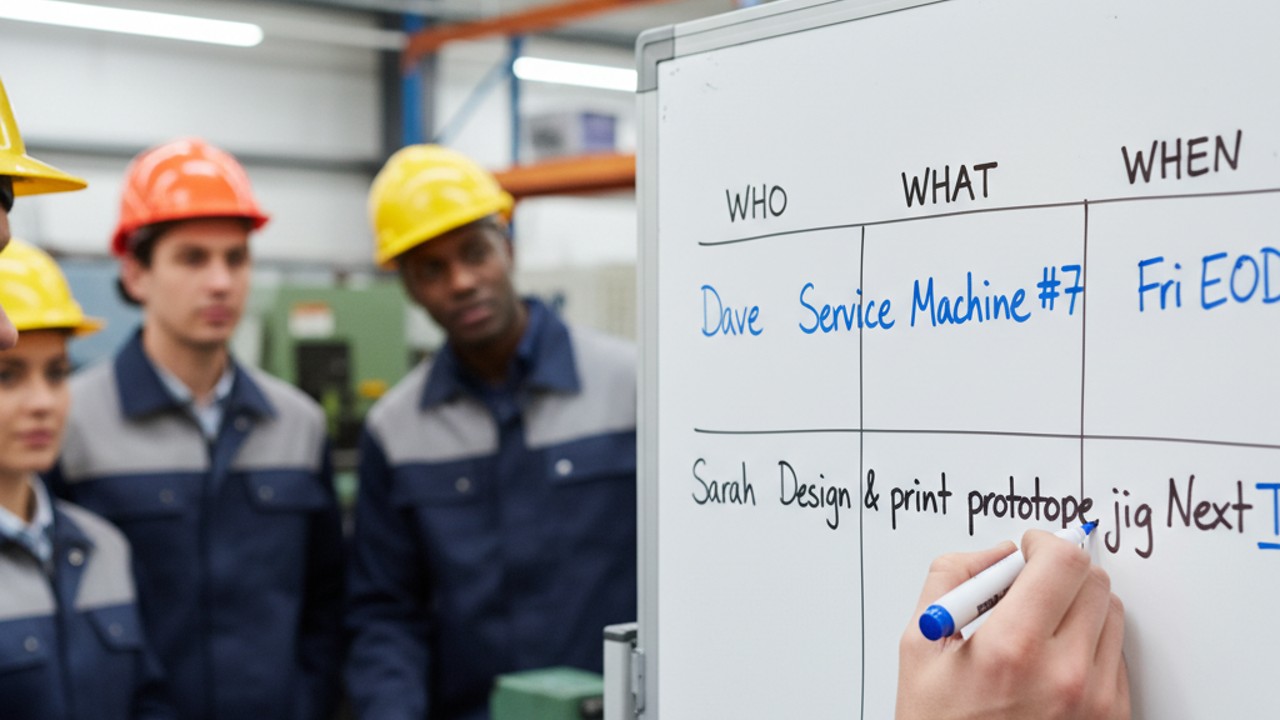
Stop Wasting Time in Meetings: The 2-Minute Fix That Actually Gets Things Done
Right, picture the scene. You’re at the end of the daily production meeting. Everyone’s had their say. The quality manager talked about a recurring issue with component alignment on Line 3. The maintenance lead mentioned that a key piece of machinery is due for a service. You’ve all nodded sagely, looked at the charts on the wall, and finished your lukewarm tea. The meeting leader says, “Okay, good chat everyone. Let’s get back to it.”
And then… what happens?
Everyone shuffles out. Some head back to the shop floor, others to their desks. But a nagging feeling hangs in the air. Did we actually decide to do anything about that alignment issue? Who is responsible for booking that service, and when are they going to do it? More often than not, everyone leaves with a slightly different version of the meeting’s outcome in their head. The result is that the same problems reappear in tomorrow’s meeting, and the one after that. It’s a cycle of talk without traction, and frankly, it’s a colossal waste of time and energy.
I’ve seen it happen in countless manufacturing businesses across the UK, from small workshops to massive plants. It’s the quiet productivity killer. But what if I told you there’s a simple, two minute habit that can completely transform this dynamic? A habit so straightforward it feels almost too easy, yet it’s the single most effective way to turn your meetings from vague discussions into engines for real, measurable action. Stick with me, because this is one of those small changes that delivers massive results.
The Forgotten Half of the Improvement Cycle
If you’ve been in manufacturing for more than a week, you’ve probably heard of the PDCA cycle. Plan, Do, Check, Act. It’s the bedrock of continuous improvement, the lean methodology mantra we all know and love. We’re usually pretty good at the first two parts.
Plan: We love to plan. We create detailed project outlines, we map out workflows, we hold meetings to discuss potential solutions to a problem. This is the exciting, blue sky thinking part. “Let’s trial a new jig to fix that alignment issue.” Great plan.
Do: We’re manufacturers, we’re people of action. We excel at doing. We’ll go out and build the jig, we’ll implement the new process, we’ll run the trial. We get our hands dirty and make things happen.
But then, something funny happens. We get so caught up in the next fire, the next urgent order, the next big plan, that we often stumble on the last two, most crucial steps.
Check: This is where we’re meant to pause and measure. Did the new jig actually improve the alignment? By how much? Did we hit the targets we set out in the planning phase? This step requires data, honesty, and a moment of reflection.
Act: Based on what we learned in the ‘Check’ phase, we act. If the jig worked brilliantly, we standardise its use across all relevant lines (Act). If it only half worked, we go back and refine it (which is really starting a new PDCA cycle). If it was a total failure, we learn from it and scrap the idea, preventing us from wasting more resources.
The Check and Act phases are where learning and genuine improvement happen. Without them, Plan and Do are just a shot in the dark. It’s like designing and building a new car engine but never actually testing it on a dynamometer or putting it in a car to see if it works. You’ve done the busy work, but you have no idea if you’ve actually created any value.
And this is exactly what happens in our meetings. The meeting itself is the ‘Plan’ phase, and sometimes a bit of the ‘Do’. But when we walk out without clear conclusions and actions, we completely skip ‘Check’ and ‘Act’. We leave the engine of improvement sitting on the factory floor, unassembled.
The Simple Habit: Two Closing Questions
So, how do we fix this? How do we bolt the Check and Act phases onto the end of every single meeting? It comes down to creating a non negotiable routine. A habit. For the final two minutes of every single gathering, before anyone is allowed to stand up or close their laptop, the meeting leader, or a designated person, must ask two simple questions.
Question 1: “To be clear, what did we decide here today?”
This question is pure gold. It’s a forcing function for clarity. It cuts through waffle, assumptions, and politeness. Someone needs to articulate, out loud, the concrete decisions that were made. Not the things we discussed, not the ideas we floated, but the actual decisions.
For example, instead of a vague feeling that something should be done about the alignment issue, the answer to this question should be sharp and specific: “We decided that the current jig is not fit for purpose and we are going to trial a new, 3D printed prototype.”
This acts as the ‘Check’ phase for the meeting itself. It confirms that everyone is on the same page. You’d be amazed how often you ask this question and get three different answers from three different people. That’s a meeting that was destined for failure, and you just saved it in 30 seconds. It forces the group to get to a single, shared understanding before they scatter. No more, “Oh, I thought we were just going to monitor it for another week.” No, we decided to act. It’s there, in the open.
Question 2: “Brilliant. So, who is doing what by when?”
If the first question is the ‘Check’, this one is the ‘Act’. It’s the accountability engine. A decision without an owner and a deadline is just a nice idea. It’s a wish. This question transforms that wish into a commitment.
It’s not enough to say “we” will do it. “We” is nobody. This question demands a name. Who, specifically, is on the hook for this?
- Who: “Sarah from engineering.”
- What: “Is going to design and print the prototype jig.”
- By when: “And have it ready for trial by next Tuesday’s pre shift briefing.”
Look at the power of that statement. It’s unambiguous. Sarah knows her task. The team knows Sarah is doing it. Everyone knows the deadline. Now, there is a clear action that can be followed up on. In the next meeting, you don’t have to ask, “So, any movement on that alignment thing?” You can ask, “Sarah, how did you get on with that prototype jig for today’s briefing?” It completely changes the conversation from reactive to proactive.
These two questions, asked consistently, are the most powerful system you can introduce to make your meetings productive. They take maybe 120 seconds, but they save countless hours of confusion and rework down the line.
Making It Stick: Practical Implementation
Knowing the questions is one thing; building them into the fabric of your daily work is another. A new habit needs a system to support it, especially when everyone is busy and defaults to old patterns. Here are a few ways I’ve seen teams successfully integrate this two-minute drill.
First, assign a specific role. Don’t just leave it to the meeting leader, who might be flustered or forget. Create a rotating role called the ‘Action Champion’ or the ‘Closer’. Their only job in the meeting is to listen for decisions and, at the two minute warning, to be the one who pipes up and asks the two questions. By rotating the role, everyone becomes familiar with the process and takes collective ownership of the habit.
Second, make it visual. We work in visual environments. We have shadow boards for tools and visual controls on our machines. Apply the same logic to your meetings. Have a dedicated space on a whiteboard or flip chart labelled ‘Decisions’ and ‘Actions (Who, What, When)’. As the answers to the two questions are given, write them down for all to see. This physical act cements the commitment. If you’re in a conference room, use the last slide of your presentation as a dedicated action capture template. When people see it written down, it becomes real.
Third, capture it digitally. The whiteboard is great for the moment, but you need a persistent record. Immediately after the meeting, the Action Champion or meeting leader should transfer those actions into a shared system. This doesn’t need to be a complex project management suite, though those are great. It could be a simple shared document, a Microsoft Planner board, a Trello board, or even just a follow up email summarising the actions. The key is that there is a single source of truth that everyone can refer back to. This closes the loop and creates a seamless trail of accountability from one meeting to the next.
The Real-World Impact: From Grumbling to Gaining Ground
Let me tell you about a client we worked with, a mid-sized engineering firm in the Midlands. Their morning production meetings were, to put it mildly, a bit of a grumble fest. The same issues with tooling, material shortages, and information gaps would come up day after day. There was a lot of talk, a lot of shrugging, and a palpable sense of frustration. The team was busy, but they were stuck in a reactive loop, constantly firefighting the same problems.
We introduced the two-minute, two question habit. To be honest, it was awkward at first. People weren’t used to being put on the spot with a name and a deadline. But the shift lead, a brilliant guy named Dave, was relentless. He made it non-negotiable.
Week one was clunky. By week two, people started coming to the meeting more prepared, already thinking about solutions because they knew they’d be asked to commit. By week four, the transformation was incredible.
The list of recurring problems started to shrink. For the first time, they were actually solving the root causes of issues instead of just patching them for the day. For example, a persistent problem with a supplier delivering incorrect parts was finally resolved because someone, let’s call him Mike, was tasked with “calling the supplier’s quality manager and agreeing on a new sign off process by Friday.” It got done. The problem vanished.
The team’s engagement shot up. They felt heard because their discussions were leading to tangible outcomes. They started taking more ownership, suggesting improvements proactively. Within three months, they had reduced minor line stoppages by over 15% and, more importantly, the general mood on the shop floor had lifted. It wasn’t a place of frustration anymore; it was a place where problems were identified and systematically crushed. All from a simple two-minute habit.
Building a Culture of Continuous Improvement
This is where the magic really happens. This two-minute habit is more than just a meeting tactic. When you practice it relentlessly, you are embedding the entire PDCA cycle into your team’s DNA. You are moving from a culture of ad hoc reaction to a repeatable system for results.
Every meeting becomes a micro cycle of improvement.
- You Plan by discussing the issue.
- You Do by getting to a decision.
- You Check by asking, “What did we decide?” to ensure clarity.
- You Act by asking, “Who is doing what by when?” to drive accountability.
This rhythm, once established, creates unstoppable forward momentum. It builds trust, because people see that commitments are made and kept. It fosters a high-performance environment where everyone understands that the goal isn’t just to talk, but to achieve. It turns continuous improvement from a theoretical concept on a poster into the practical, everyday way your team operates.
It’s the difference between a team that is constantly busy and a team that is consistently effective. And it all starts with having the discipline to save the last two minutes of every meeting for the only two questions that truly matter.
Ready to Build Your High-Performance Team?
If this idea of embedding simple, powerful habits to drive real results resonates with you, then you’re ready to take the next step. Transforming a team’s culture doesn’t happen by accident; it happens by design.
I invite you to join our upcoming High-Performing Teams Workshop, created specifically for leaders in the UK manufacturing sector. This isn’t a theoretical lecture; it’s a hands-on session where we’ll equip you and your team with the practical tools and routines needed to foster a culture of accountability and continuous improvement.
In the workshop, you will gain:
- A toolkit of practical habits, like the 2-minute meeting closer, to drive clarity and action.
- Proven team routines for problem solving, communication, and performance tracking.
- Customised coaching to help you embed these new systems and make them stick within your unique operational environment.
Stop letting your meetings be a black hole for time and energy. Start building a system that guarantees forward momentum.
To learn more or to reserve your spot, please visit High-Performing Teams Workshop or call us directly at 0330 311 2820. Let’s build something great together.
More Blog Posts







To leave me a message or book a return call at a time that suits you








